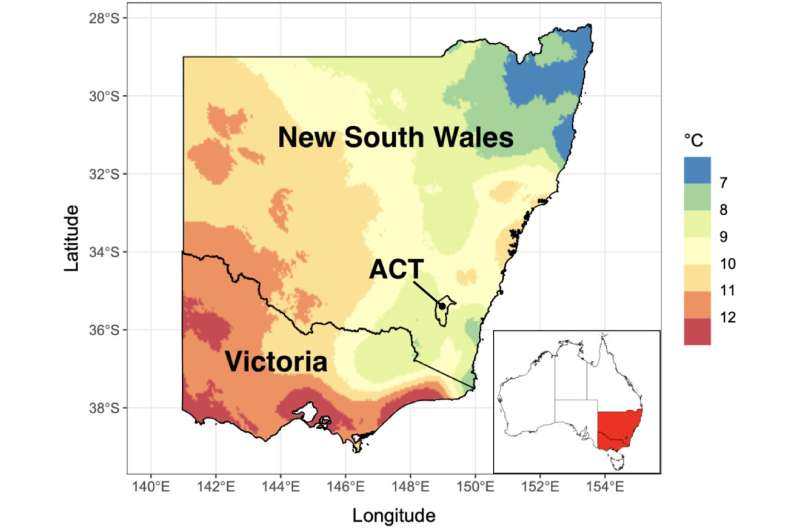This article has been reviewed according to Science X's editorial process and policies. Editors have highlighted the following attributes while ensuring the content's credibility:
fact-checked
peer-reviewed publication
trusted source
proofread
Bigger, wilder, more destructive: How cold fronts affected the Black Summer bushfires

Cold fronts play a role in making bushfires drastically worse—posing a serious concern for future bushfire events.
UNSW Canberra Professor of Bushfire Dynamics Jason Sharples says that while the relationship between bushfires and cold fronts may seem counterintuitive, it is important to understand the implications for future fire seasons.
"People often associate cold fronts with cooler temperatures and rain, so you might not think that would exacerbate bushfires," Prof. Sharples says.
"But before a cold front passes over southeast Australia it will typically draw hot and dry northwesterly winds from Central Australia to the region. This can dry out fuels and lead to more dangerous fire weather."
Prof. Sharples and other researchers from UNSW Canberra, with colleagues at the Australian National University (ANU), studied the impact of cold fronts during the devasting 2019–20 Black Summer bushfires, and found they increased dangerous bushfire conditions and led to bigger and more erratic fires. The findings are published in the journal Environmental Research Letters.
By studying sea level pressure charts and the significant temperature drops associated with cold fronts, researchers determined that 46% of the 50 large fire days during Black Summer coincided with cold fronts passing over southeast Australia.
Bushfires changing behavior
"As the front approaches, winds get stronger and can abruptly change direction, which can change the size and shape of a fire front and lead to erratic fire behavior," Prof. Sharples says.
"Cold fronts also lead to atmospheric instability which, when coupled with the extreme fire, can cause a pyrocumulonimbus, or fire thunderstorm. There were 44 of these events during Black Summer, more than we've ever seen in a single season before."
The Black Summer bushfires were unprecedented in terms of size, intensity and destruction, sweeping across nearly 7.2 million hectares in southeast Australia. Evidence suggests the risk of extreme bushfire seasons, like the Black Summer, will increase in future.
It has been well established that the effects of human-caused climate change are leading to more dangerous bushfires, but the way that climate change might affect cold fronts and their impact on a bushfire season remains uncertain.
New observation about bushfires
ANU Professor of Climate Science Nerilie Abram says the research into the Black Summer fires was the first time cold front activity had been proven to exacerbate fires across an entire fire season.
"We had previously seen cold fronts escalate disastrous conditions during individual bushfires, but to prove it across an entire season is significant," Prof. Abram says.
"Twenty-three days during Black Summer saw large areas burn and also experienced a passing cold front, indicating that this association was a consistent pattern rather than coincidence.
"Our research also showed that the frequency and intensity of strong cold fronts were unprecedented in many of the areas that burned during Black Summer. This highlights the impact synoptic weather activity can have on bushfires.
"Importantly, our findings also showed that the extreme cold fronts experienced during the Black Summer were part of a long-term change in weather patterns over southeast Australia during the past 70 years."
The increasing severity of bushfires
UNSW Canberra Associate Professor of Climate Science Sarah Perkins-Kirkpatrick says destructive bushfires being exacerbated by cold fronts is a worrying trend for Australia.
"All the evidence points to worsening bushfire conditions in the decades ahead due to greenhouse gas emissions causing climate change," A/Prof. Perkins-Kirkpatrick says.
"There is an increased likelihood of hotter and longer heatwaves, which could lead to greater drying out of fuel loads and more devastating bushfires.
"All of this combines to paint a pretty bleak picture of what is to come.
"This research again highlights the urgent need to limit and reverse the effects of climate change to reduce the chance of extremely dangerous and deadly bushfires."
More information: Dejun Cai et al, Increasing intensity and frequency of cold fronts contributed to Australia's 2019–2020 Black Summer fire disaster, Environmental Research Letters (2022). DOI: 10.1088/1748-9326/ac8e88
Journal information: Environmental Research Letters
Provided by University of New South Wales




















